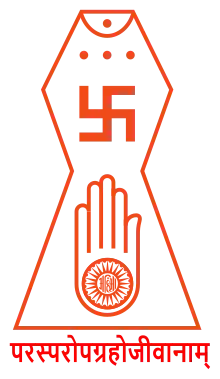Tapa Gaccha
Tapa Gaccha is the largest Gaccha (monastic order) of Svetambara Jainism.
| Part of a series on |
| Jainism |
|---|
 |
History
Tapa Gaccha was founded by Acharya Jagatchandra Suri in Vikram Samvat 1285 (1228 AD). He was given the title of "Tapa" (i.e., the meditative one) by the ruler of Mewar. This title was applied to the group.[1]
Under Vijayanandsuri's leadership and other monks, Shwetambara Murtipujak Conference was established in 1893 which reformed mendicant as well as lay religious practices. As a result of this reform, most Shwetambara Jain monks today belong to Tapa Gaccha.[1]
Today, the majority of its followers live in states such as Gujarat, Maharashtra, Tamil Nadu, West Bengal, Punjab and Rajasthan.[2]
Denominations
Later Tapa Gaccha is followed by 21 different samuday or orders. The sects follow different rituals but they do not have differences about scriptures.[1]
Some of these differences include Tithi (calendar date), veneration of gurus, pilgrimage of Palitana temples during monsoon and Santikaram (a religious text) chanting on Chaturdasi (14th day in each half of month in Jain calendar).[1][3][4]
Till the time of Nemisuri, there was a unity in Tapa Gachcha. Ramchandrasuri of Prem Suri separated from his guru and started 'Be Tithi Paksh' with the view that religious ritual Tithi can be omitted or held more than one time in the religious calendar. In 1935, on Samvatsari, the last day of Paryushan, Ramchandrasuri order observed it on a different day.[4] This became a sectarian issue and Tapa Gaccha separated into new Be Tithi Paksh or 'two date fraction' and existing Ek Tithi Paksh or 'one date fraction'. Anandji Kalyanji Trust, which manages 1200 Jain temples, unsuccessfully attempted several times to resolve the issue. In 1986, Ramchandrasuri order formally separated from Premsuri order.[4]
Other distinguishing factors include veneration of gurus using Vasakshep (a sandalwood powder used for worship) between these two fractions. Be tithi fraction believe that Guru or Acharya should be venerated by Navangi Guru Poojan, spreading powder on nine points of body while Ek tithi fraction believe that it should be spread on one point of body, Akangi Guru Poojan. Both fractions differ on pilgrimage of Palitana temples on mount Shatrunjay by lay persons during monsoon season.[4]
References
Citations
- John E. Cort (22 March 2001). Jains in the World : Religious Values and Ideology in India: Religious Values and Ideology in India. Oxford University Press. pp. 42–46. ISBN 978-0-19-803037-9. Retrieved 6 August 2014.
- von Glasenapp, Helmnuth. Jainism: An Indian Religion of Salvation. p. 389.
- "HC order on Jains' worship". The Hindu. Mumbai. PTI. 30 July 2000. Archived from the original on 12 August 2014.
- Peter Berger (2010). The Anthropology of Values: Essays in Honour of Georg Pfeffer. Pearson Education India. pp. 336–337. ISBN 978-81-317-2820-8. Retrieved 9 August 2014.
Sources
- Cort, John E. (2001), Jains in the World: Religious Values and Ideology in India, Oxford University Press, ISBN 978-0-19-803037-9
- Jain, Kailash Chand (1963). Jainism in Rajasthan. Gulabchand Hirachand Doshi.
- "The religious leaders of Jain s and their ladder or leadership" (PDF).
- Jain, Babulal (2006). Samagra Jain Chaturmas Suchi. Mumbai: Ujjawal Prakashan Kandivali.